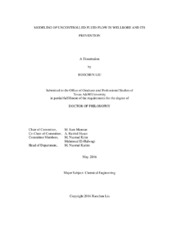| dc.description.abstract | Uncontrolled fluid flow in the wellbore is one of the most critical safety concerns for the oil and gas industry. The major focus of this dissertation is on blowout events given the most severe consequences associated with such incidents. The past tragedies reflect a strong need for not only understanding the mechanisms of blowout to accurately estimate the consequence, but also the approaches to managing and controlling the risks, uncertainties, and hazards associated with blowout events.
A fully integrated analytical model that couples the reservoir and wellbore has been proposed to investigate the fluid behaviors during the blowout events. This model could be used to simulate any potential blowout events for gas, oil, or oil/gas wells at onshore or offshore facilities. The reservoir, wellbore, and their interactions are coupled together to demonstrate a full picture of the potential well blowout incidents. The results reveal that understanding the importance of heat transfer and multi-phase flow behaviors is essential to accurately estimate the consequence of well blowouts. Well-established computational algorithms are developed to effectively estimate the blowout rate and total discharge amount during blowout incidents. The statistical analysis identifies the independent variables responsible for the maximum discharge; both reservoir permeability and the connected reservoir volume are the key variables.
The results of the blowout modeling could serve as the input for both consequence-based and risk-based approaches to assess the risk associated with the blowout events. The application of such approaches is demonstrated by the case study. The consequence-based approach is easier to be implemented and provide guidance to the operators based on the realistic worst-case scenario. It would be useful for drilling site location selection and preparation of emergency response plan. On the other hand, the risk-based approach enables the operators to have a comprehensive understanding of the particular well that they are working on, so that the risk associated with the blowout events can be effectively managed and controlled. The risk reduction plan based on the blowout risk assessment is also discussed in this dissertation. | en |


